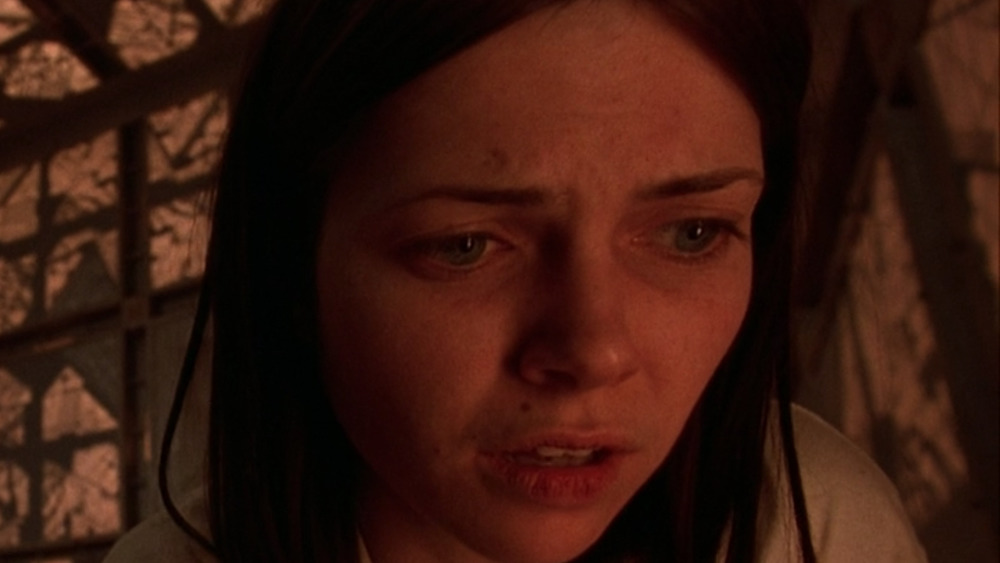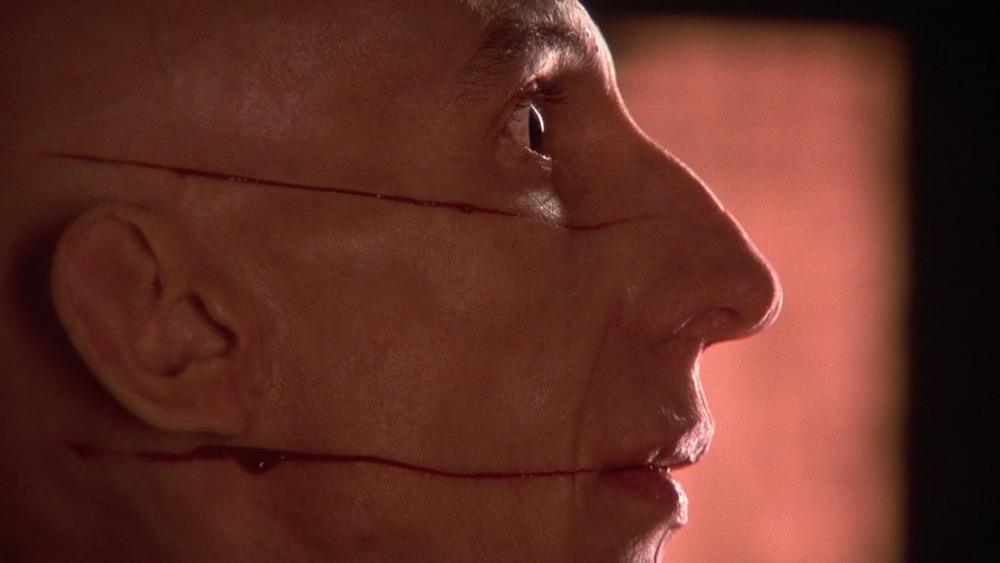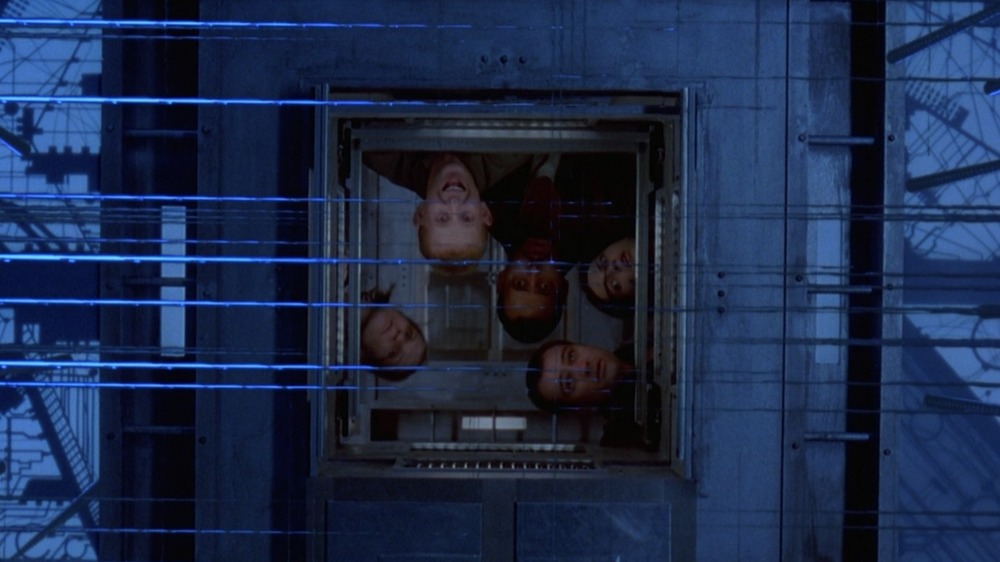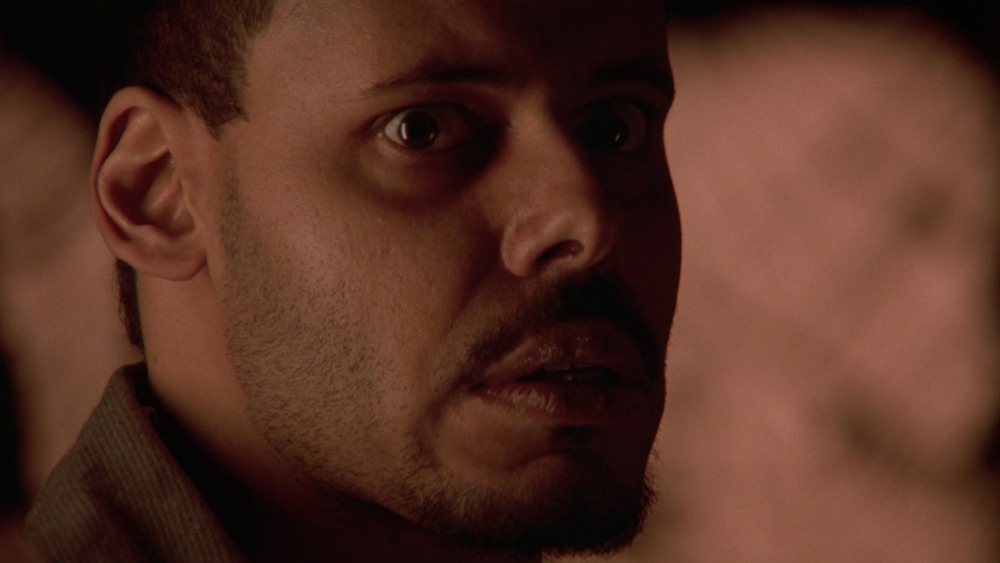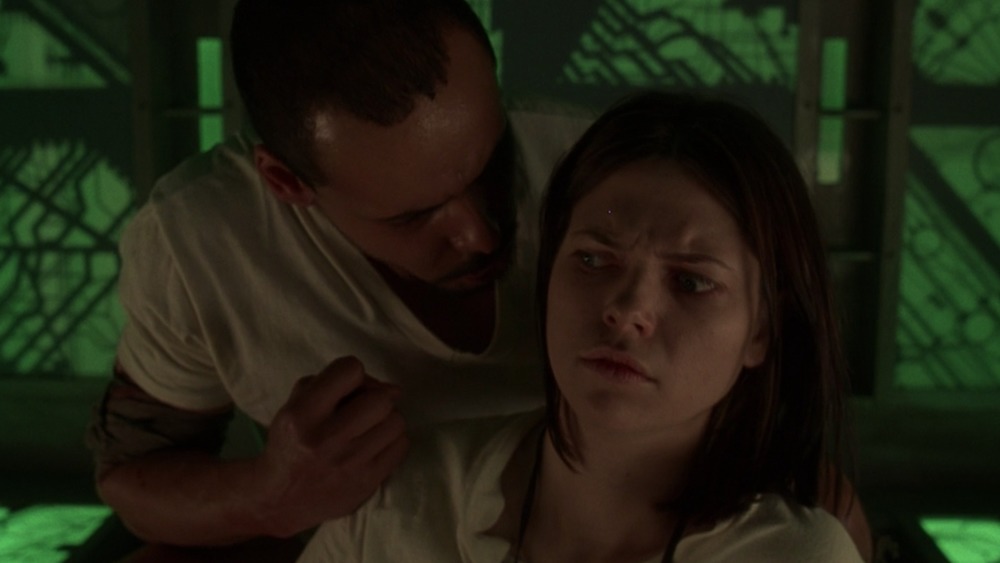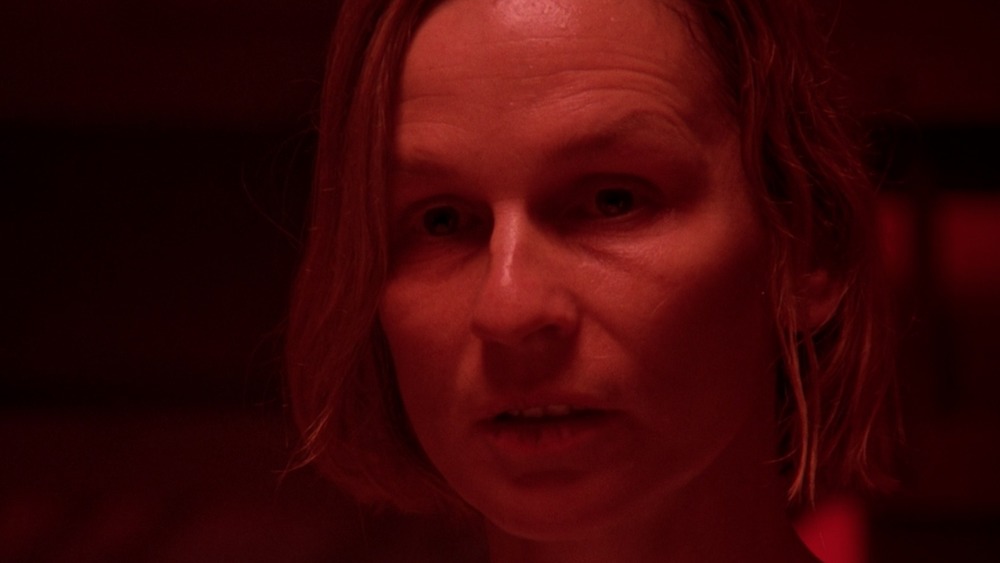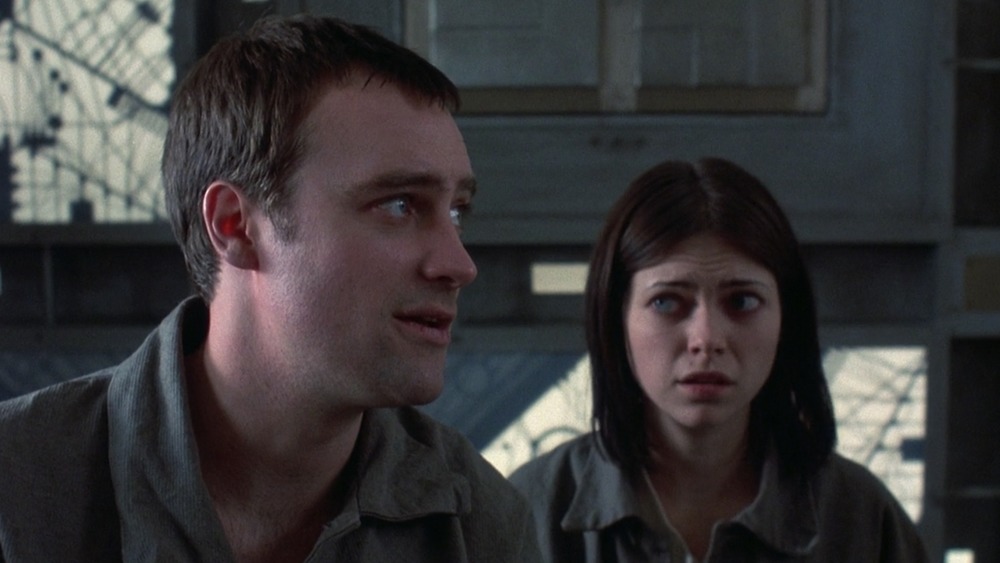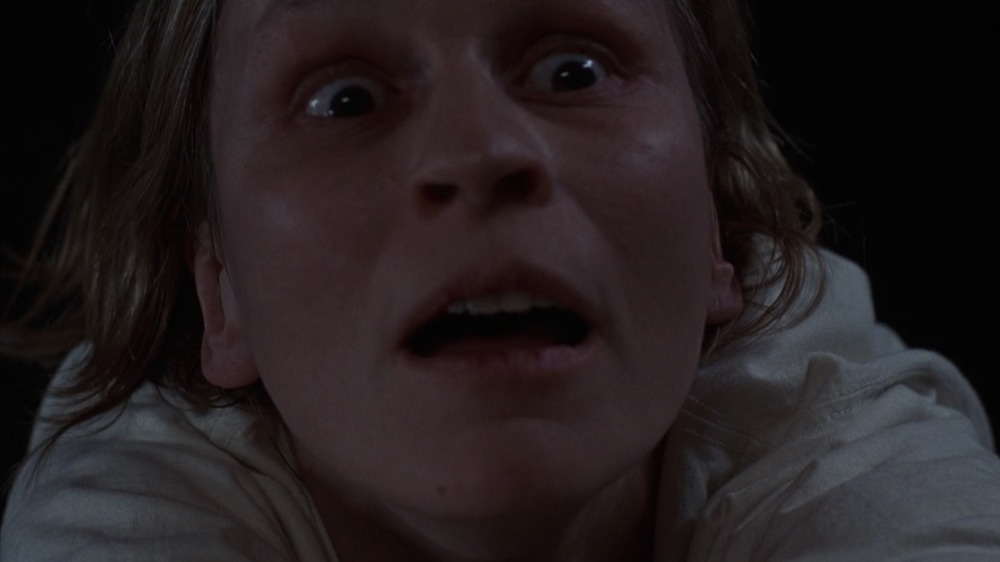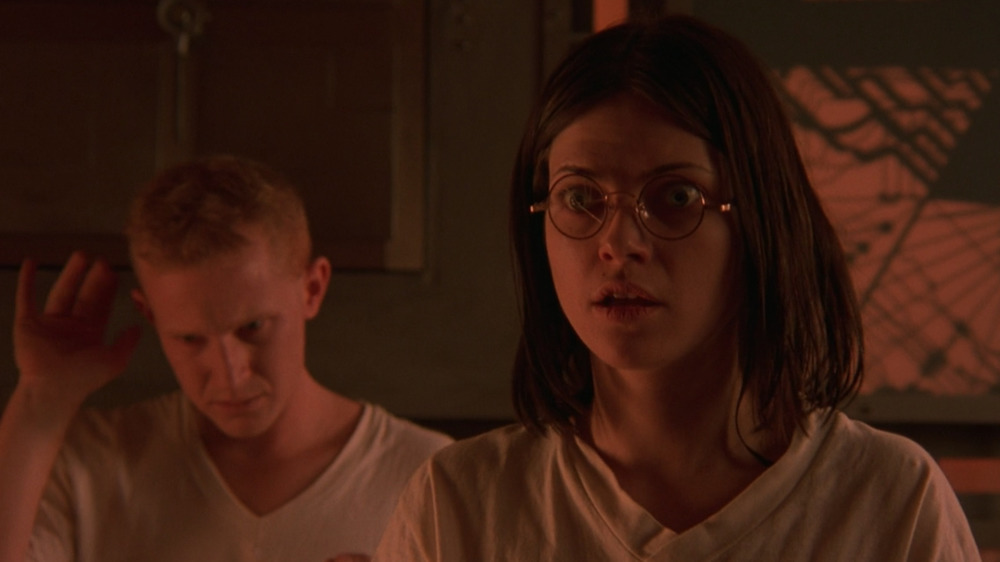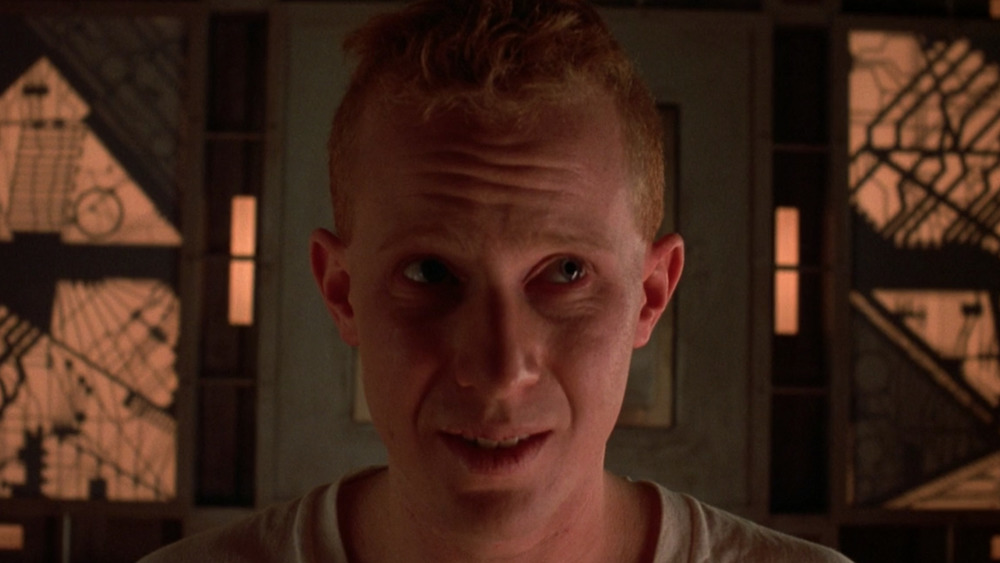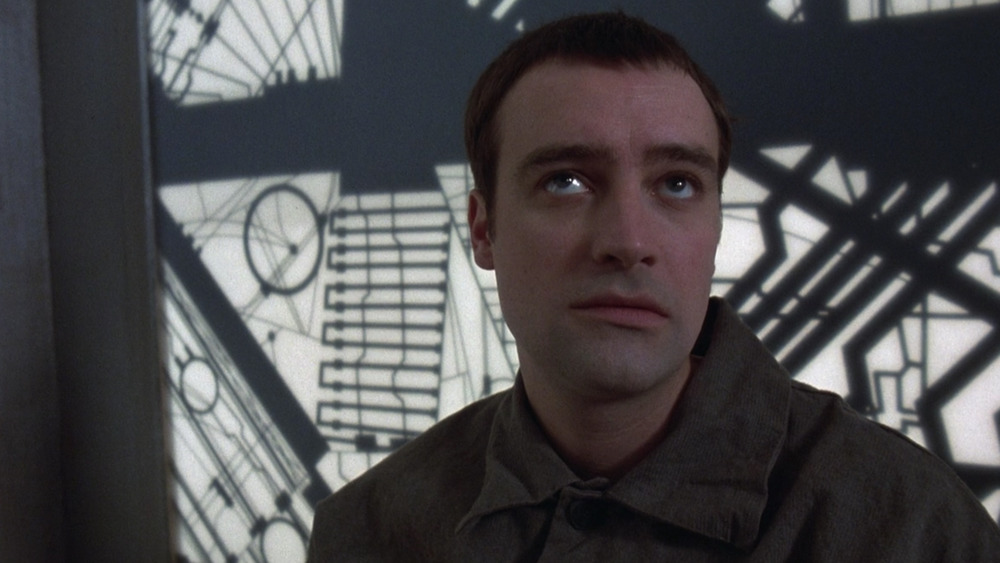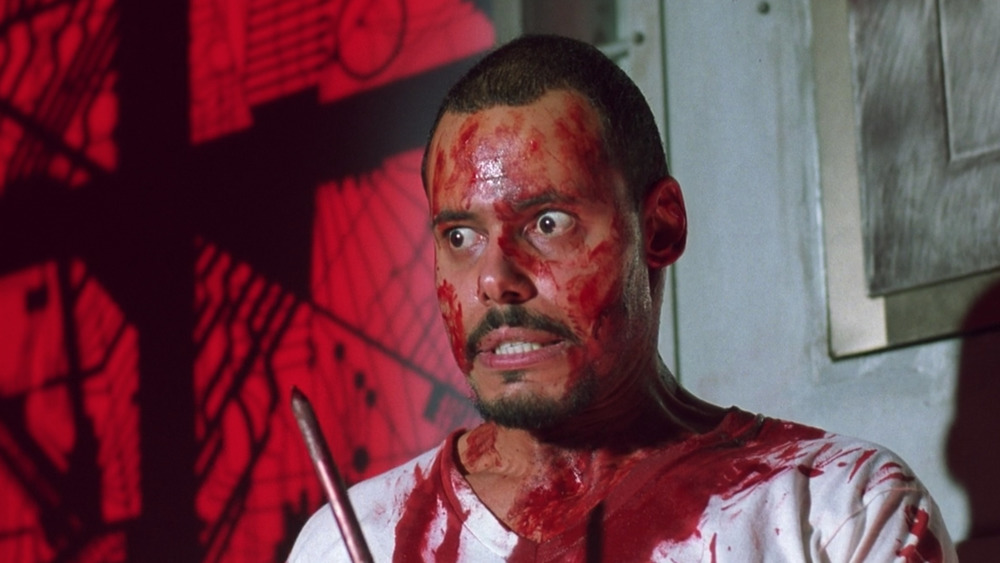The Ending Of Cube Explained
Good science fiction thrillers are a rare breed, especially when you consider the budget requirements needed to meet audience expectations of visual razzle dazzle. In 1997, Cube opened in a modest 16 theaters, and pulled in a measly $500,000 in sales on a film budget of $350,000. This dismal theater run was a humble beginning for what would become a cult hit. Thanks to word of mouth and intellectual curiosity, Cube continued on to see a wider release across the globe, and its returns soared into the millions. This sustained rise in popularity resulted in subsequent films Hypercube and Cube Zero, a sequel and a prequel, respectively.
Cube follows several strangers who awaken in a mysterious series of rooms, all linked together to form a massive cube construct of unknown origin. An unsettling number of rooms contain elaborate death traps, such as flamethrowers, room-spanning death spikes, and face-melting acid. The people in the Cube don't seem to be connected in any way, and are oblivious to their place in the grand scheme. An ambiguous ending leaves viewers to ponder the film's meaning — and also work on their mathematics knowledge. If you are still questioning the intricacies of Cube all these years later, you've nestled into the appropriate corner of cyberspace. This is the ending of 1997's Cube, explained.
Waking up in the most elaborate escape room ever constructed
Before an ominous title sequence rolls, Cube offers a taste of what gruesome delight is in store. A man gingerly meanders from one room to another, when he is suddenly filleted into neat little meat cubes by a deadly trap. This glimpse of the device's awful capabilities adds palpable tension as we watch five people converge in a glowing white room within the Cube. Each person is baffled as to their circumstances, and has no memory of how they got there.
Standard escape-room operating procedure would call for probing any bookshelves and picture frames for hidden keys. But there is nothing distinct in any of the rooms, beyond differently colored lighting. All six sides of each room are equal in size, and feature a door leading to another room in every direction. The captives attempt to analyze each other's backgrounds in search of clues that could help them shatter the grand illusion, but each possibility only leads to more questions. They are forced to take the only route available: They push forward and move from room to room in search of an exit. Logically, this feels like the right move. Eventually, they should reach the edge — the rooms can't go on forever, after all. Right?
There are deadly traps in some of the rooms
As we see in our introduction to Cube, there is a possibility that moving into a new room might transform you into human sushi. Rennes, a resourceful member of the party, develops a rudimentary method to test for traps by throwing boots into adjoining rooms. It proves reliable, until Rennes steps into a supposedly trap-free room, and the Cube lobs a faceful of corrosive acid at him. This unexpected death demands a new approach, because obviously, there is more to the Cube than meets the eye.
We initially assume that the color coding of each room will factor into the Cube's machinations, but you should actually cast that assumption aside. The different colors of each room are only used as a cinematic tool — they're a clever way for the low-budget film to portray multiple rooms with the same set. The key to escaping the diabolical plot device is actually all about math. Each door bears a set of numbers etched into the metal. These numbers offer up a way to avoid any deadly traps. The resident mathematics major, Leaven, concludes that trapped rooms contain prime numbers on their door label. Testing the method proves fruitful. The group now has a sound method for moving inside the Cube. They only have to be careful not to collapse from within.
Fear and paranoia take the stage
Human beings have difficulty embracing chaos. The idea that circumstances could occur for no reason is thus unacceptable in the eyes of Cube's characters. When Rennes delivers his inspiring little speech about how "you gotta save yourselves from yourselves" and is promptly reduced to a meat crater, his death signifies the death of his ideology as well. A new dictum reigns: Only look at what's in front of you, and keep moving.
This incident also sparks an overwhelming desire to assign blame. Particularly susceptible to madness is Quentin, who proves to be a loose cannon, and starts to develop wild theories about their surroundings, such as their demise being "some rich psycho's entertainment". When Worth reveals that he contributed to the Cube's construction, you would assume he either has knowledge they need, or is a spy planted in the group to ensure their demise. In response to this uncertainty, Quentin becomes enraged and assaults Worth, then forces him to become the group's test dummy for entering new rooms. This development in the group's dynamics is a glaring statement about the movie's true intentions. Every person in the group wakes up in the same situation: trapped in the Cube. Yet, rather than aiming their frustrations at their surroundings, they begin viewing each other with suspicion and fear.
The metaphorical within the theoretical
While major elements of Cube have you struggling to remember geometry class, one of the film's underlying messages might slide right past you. The captives' prison is nowhere near as dangerous as they themselves are — as the saying goes, wherever you go, there you are. No one inside the Cube is in control. Yet they all possess a small piece of what could be the key to their release. Rather than work together for a better outcome, however, they end up turning on each other — and therein lies the point of the movie.
Not only is everyone in the Cube slowly succumbing to dehydration and starvation, but they're also angered by the annoying fact that there is no one to blame. "There is no conspiracy. No one is in charge. It's a headless blunder operating under the illusion of a master plan," explains Worth, attempting to spread his ideals of futility. This logic can be hard to accept while struggling to deduce reason from mayhem, but this is, in fact, the primary message of the whole film. Cube is one giant metaphor, packaged as a sci-fi horror film. The true mastermind behind this death machine is non-existent, unless you count humanity as a whole, and an inability to accept that dooms the characters.
The left hand never knows what the right is doing
The revelation that Worth played a part in the construction of the outer shell is information you would expect to reveal an escape route. But all it does initially is make Quentin angrier and supply a small bit of knowledge of how large the Cube is: 26 by 26 by 26, for a grand total of 17,576 rooms. Unfortunately, Worth only has knowledge about the outer shell and not much else. He can only expand on the film's point: No one has a clue as to what is going on. The resulting paranoia from this information is expressed by Holloway: "You keep everyone separated so the left hand doesn't know what the right hand is doing."
Holloway believes knowledge of the whole structure is kept hidden from each individual who has helped make it. This is only halfway true. Indeed, no single person working on the Cube has knowledge of everything involved, and that lack of information may seem like intentional withholding, which implies a grand scheme. But in actuality, these cogs make up a machine that's trudging along with no pilot — an equally terrifying headless horseman.
The Cube is pointless -- and that's the point
The overarching ideology of Cube gets a bit twisted when one considers the point of the central structure. The existence of the Cube seems extremely unnecessary: What possible use could people have for a monstrous prison filled with thousands of potentially deadly rooms? There has to be a reason it exists, because constructing a mechanism as vast as this would take the coordination of extremely wealthy individuals or governments. Right? Well, not necessarily.
The point of Cube is that there is no point. Worth's dialogue helps drive this home, when he explains that the only reason people are put into the Cube is because not doing so would mean admitting that the Cube is pointless. "But it IS pointless!" exclaims Quentin, when he is presented with this logic. "That's the point," Worth replies dryly. Therein lies the quirky appeal of this sci-fi horror flick: The Cube is an enormous and unthinkably complex machine, churning along for no other reason than to merit its own existence.
The characters begin to destroy each other
Rather than aiming their resolve at the situation and working together to get out, everyone in Cube begins turning on each other — especially Quentin. The infuriating prison does nothing but stoke his anger. He succumbs to the delusion that he can see into people's minds, but in reality, he seamlessly projects his fears onto everyone around him. Holloway recognizes this, and rather than using it to her advantage, she uses it to verbally attack him and expose his true nature. In response, Quentin intentionally lets her fall off the edge of the Cube, and justifies the act with the logic that she knew too much about him, so she must be in on the whole thing.
For the most part, all the main characters in Cube are harmed by each other, and not their three-dimensional prison. The only thing that stops everyone from beating each other to death are the numbers in each room. They are the group's only real answer to what they all ultimately want: A way out. Thankfully, there is a mathematician on board, as well as a human calculator.
Using math to understand the Cube
Every teen who's ever wondered why they need to know math in the real world should be shown Cube. Not only do you need math in order to count money, it also comes in handy when you wake up in a gigantic death maze. Initially, we think that the door numbers only reveal traps, but Leaven is able to use their knowledge of how big the cube is in combination with the door numbers to plot their position. This allows them to find the shortest route to the edge of the Cube, so they can make better sense of their surroundings.
The trip spins them around until they arrive back at the room that Rennes died in at the beginning of the film. Everyone believes they've just spent all their time going in circles, but Worth points out that the room Rennes had gotten an acid peel in is gone now, and they were at the edge. The room has vanished. This means the rooms have been shifting around them while they have moved through the Cube. This awareness changes how Leaven analyzes the numbers, enabling her to even more accurately decipher how they can escape.
Plotting their position inside the Cube
Every new piece of information reveals a more complex language within the Cube's number sequences. Now that Leaven knows the rooms have been moving, she realizes she must use Cartesian coordinates. We aren't going to pretend to be math whizzes, so we'll just say that with this knowledge, she is able to plot their position within the Cube. The group is able to figure out where they are, where they need to go, and how much time they have.
A pleasant surprise comes in the form of Kazan's incredible number-crunching brain: He is able to factor out extremely large numbers and accurately uncover which rooms are booby trapped. Everything becomes clearer about their surroundings once they know how to accurately analyze the number system of the Cube. Leaven and the others are now able to efficiently move through the Cube towards what they believe to be the exit. All the pieces slide into place, and everything converges in Cube's final moments.
Back to where it all began
Earlier in Cube, Leaven is briefly baffled by a room having a coordinate of 27. This is puzzling information, considering they know the Cube is 26 rooms across: A coordinate of 27 would place that room outside of the Cube. It turns out that this particular room serves as a bridge towards the outer shell, where they can escape. For a short time, this room will allow them to exit, but afterwards, it plugs itself back into the rest of the Cube and begins rotating through the entire mechanism again. The characters are disheartened to thus realize that if they hadn't moved at all, the room they started in would have eventually returned to the exit.
Now that Quentin has the information he needs, he gradually becomes more domineering and controlling. It's obvious that Quentin views his fellow prisoners as tools he can use to escape. Recognizing where things are heading, the rest of the group traps him in an adjacent room and races towards the exit. Leaven leads the group towards the appropriate room at the edge of the Cube. Now, all they have to do is wait until the bridge room slides into place, and then they'll be homeward bound.
The final room
At last, the group reaches the final room, which is bathed in glorious sunlight. Worth hesitates for a moment, reluctant to return to a life he is unhappy living. During this brief moment of contemplation, Quentin slithers into the room with them and impales Leaven through the chest. He then stabs Worth, and turns toward Kazan. Kazan jumps out into the daylight, and Quentin begins to step through after him. Worth musters up his last bit of strength and grabs hold of Quentin as the rooms begin to shift. Quentin struggles, caught between the moving rooms, but to no avail. He ends up becoming a smear of red across the Cube's shell.
In the end, Kazan is the only person to escape. He will not be able to describe everything that happened inside the Cube, which means that the entire machine will keep churning along. No one will be given the knowledge of how they plotted their location with numbers, or how they figured out which rooms had traps. It is likely that the dimensions of the Cube die along with Worth as well. As far as a linear plot goes, nothing that happens in the Cube changes a single thing, which is kind of the point. But when you say it like that, we can definitely understand the desire for a sequel.
